
Odonthalia washingtoniensis
Toothed-Twig Seaweed, Flat Sea Brush
Gonzales Bay, Juan de Fuca Strait, B.C., Canada
2 January 2023 – Collected at 3:30pm PST
Formal Interactions & Observations commenced 3 January 2022
Low tide 2.3 feet at 19:11pm PST (measured at Oak Bay Tidal Station)
Weather: Overcast, light variable winds, no precipitation, light chop, temperature 5 ˚C, relative humidity 82%.
Phase of Moon: Waxing Gibbous, 84.9% or 10 days past the new moon; (Previous Phase, First Quarter, 29 Dec 2022 at 5:20pm PST; Next Phase, Full Moon, 6 January 2023 at 3:07pm PST.)
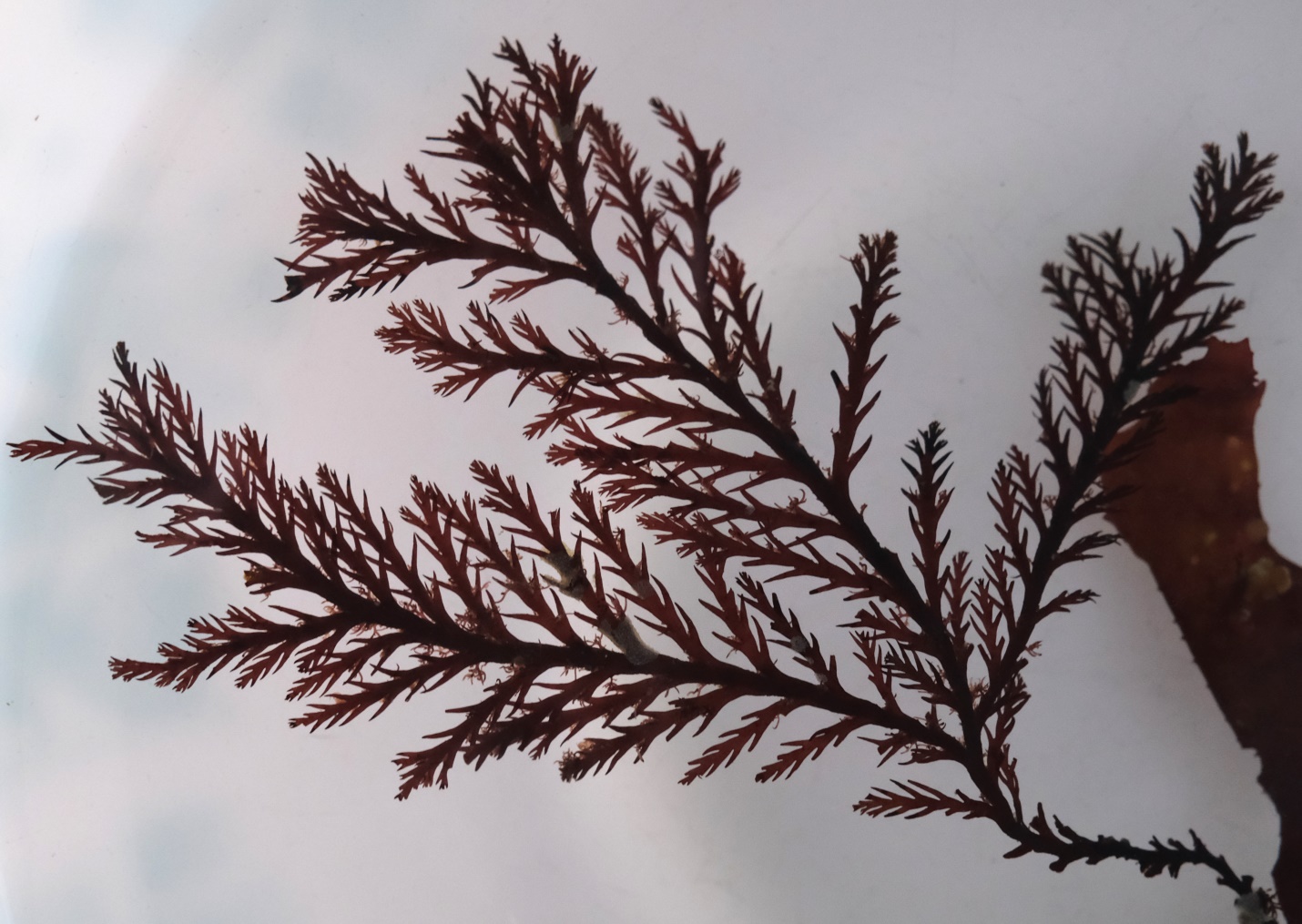
Figure 1: Phycologists proclaim that this beautiful seaweed is “a prize to find!” Displayed here in our observation basin and gently lit from behind, the vibrant coloring of this red alga can be appreciated. The tendency for this alga to look almost black in color can also be understood. Gonzales Bay, Juan de Fuca Strait, B.C., Canada. January 6, 2023. Photo ID 27500 ©Seaweedwhisperings.com
Person 1:
This beautiful specimen caught my eye amongst the other washed-ashore seaweeds. We had seen many other individuals, but this one stood out.
From the distance, O.W. has a very distinctive, simple beauty, very much resembling a conifer twig, most like a cedar or juniper.
Strong and vibrant.
Two-dimensional, everything seems flattened, but at the same time not compressed. Seems to like the simple, straight-forward 2-D life, with no need to explore beyond.
Although it looks like it might be spiny or bristly, it’s actually relatively smooth/soft to the touch.
The deep red color goes well with the pattern of the blades – certainly stands out.
Confident, comfortable, but not boastful.
I’m wondering about its stem towards the base..., looks like it may lose its first branches as it grows bigger. This is like a conifer that sheds its lower branches as they get shaded by the canopy.
Contrasting with many other seaweeds O.W. confidently holds its shape no matter where it finds itself.
Very accomplished in what it does, but not particularly interested in finding new ways of doing things, or expanding its horizons.
Quietly understated.
When pushed to other dimensions, it quickly returns to its comfortable plane and resumes life as before.
Branches are not quite symmetrical in form, so O.W. may appear to be exploring, but in reality is just working the same two-dimensional theme.
Looking with a hand lens, we can see tiny odd-looking structures that have irregular, sweeping hooks. Reproductive structures?
Is O.W.’s sexual behavior unconventional? Deviant?
Is such behavior masked by the outer appearance of success and accomplishment?
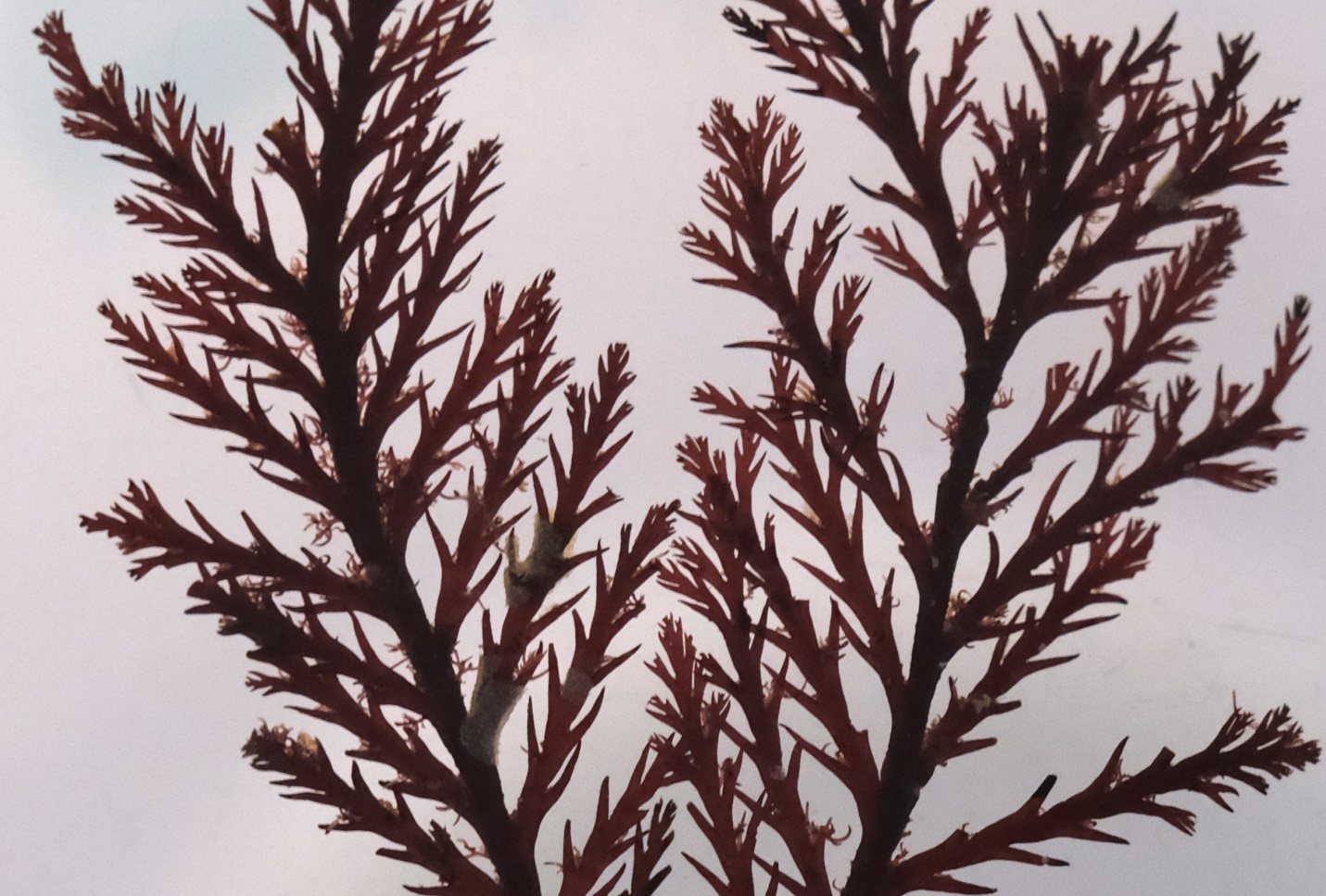
Figure 2: A closer view reviews the alternate branching pattern of this seaweed, and tucked in close to the branches and branchlets are much smaller conglomerations of curled growths. These are reproductive structures at a quite early development stage. Gonzales Bay, Juan de Fuca Strait, B.C., Canada. January 6, 2023. Photo ID 27501 ©Seaweedwhisperings.com
Person 2:
I took a first glance and thought, “Oh, this is a pretty specimen.” A very lovely red.
The pattern of the branches is very attractive; simple, neat, small branchlets all angled in a uniform direction, pointed gracefully. Laid out on a flattened plane.
The overall look is strikingly reminiscent of a cedar tree twig.
But the feel or energy of the look – neat, pointed, angling forward in one direction, there is strong determination behind this.
What are you striving for, Odonthalia washingtoniensis?
What is your focus?
You seem intent in it.
Your red is lovely, rich, has depth to it. And it seems to signal your vitality, too. Other specimens I’ve found have been such a darkened red that they look almost black – that seems to be for you the color of death and decay.
Person 1 collected you yesterday afternoon, after you had been washed up on the beach. He was attracted to you, wanted to interact particularly with YOU – the finest specimen of your species we encountered on the whole beach.
His, and then our, interest carried over in a certain way. We had decided to wait until the next morning to begin our intentional interactions with this seaweed; the thought was we’d be clear and fresh in the morning. We both woke early, at 4:00 a.m. with the thought, “Oh, I think our seaweed friend is ready and waiting for us”.
Was Odonthalia ready earlier than we were, possibly? Ready and not yet overly impatient to be waiting for us, BUT certainly not quite able to see what the delay was about.
So is this again another kind of determination or intensity? When the task is identified and chosen, well, then GET ON WITH IT!
The texture of this seaweed is firm and even stiff. The branches and branchlets do not droop but remain in place in their plane of expression. Even the tiny pointed ends are firm, although they are not prickly like spines.
The genus name, Odonthalia, suggests others see all these leading points as “teeth”.
If they are teeth, they’re certainly pointed ones, not molars but possibly incisors or fangs?
Just what do you sink your teeth into, Toothed-Twig Seaweed?
It seems that with teeth such as yours, you would grab on and never let go. Are you tenacious in this way? I think you can be. And do you sometimes not have the capacity to release your bite when it might better serve you to do so?
Determination on overdrive, perhaps. Yes, this can be true for you, Odonthalia.
Our specimen was washed ashore entire. It appears as if it may have been growing affixed to a young Prionitis sp. seaweed, or possibly vice versa. It is impossible with my eye or hand lens to tell which was which, but the two of you are joined at your bases.
A subtidal species, we only find Toothed-Twig Seaweed washed ashore. And at this season this particular specimen is also showing reproductive growths. They look very new, just growing in and once I found them I saw that they are interspersed all along the main axes and the side branches, too. They are somehow quite other-worldly looking in structure and are comprised of a central ‘part’ that feels spherical which is ‘protected’ by longer, incurving projections (several to each cluster). These projections could indeed be thought of as tusks or fangs, they share that look but not the hard texture.
Pattern again – there is a pattern to these reproductive growths.
And your branches, they always are alternating (not opposite); this side, then the other side, this side, then the other side in a neat and orderly spacing. This alternating pattern is followed at all levels of branching right out to the finest points.
Fine, pointed, trim – you are not one to indulge in embellishments, Odonthalia washingtoniensis. Possibly you actually abhor them. Yes, I think you feel quite strongly about that.
Keep it simple!
Nothing is to be missed, but also not one more thing than is necessary is to be included.
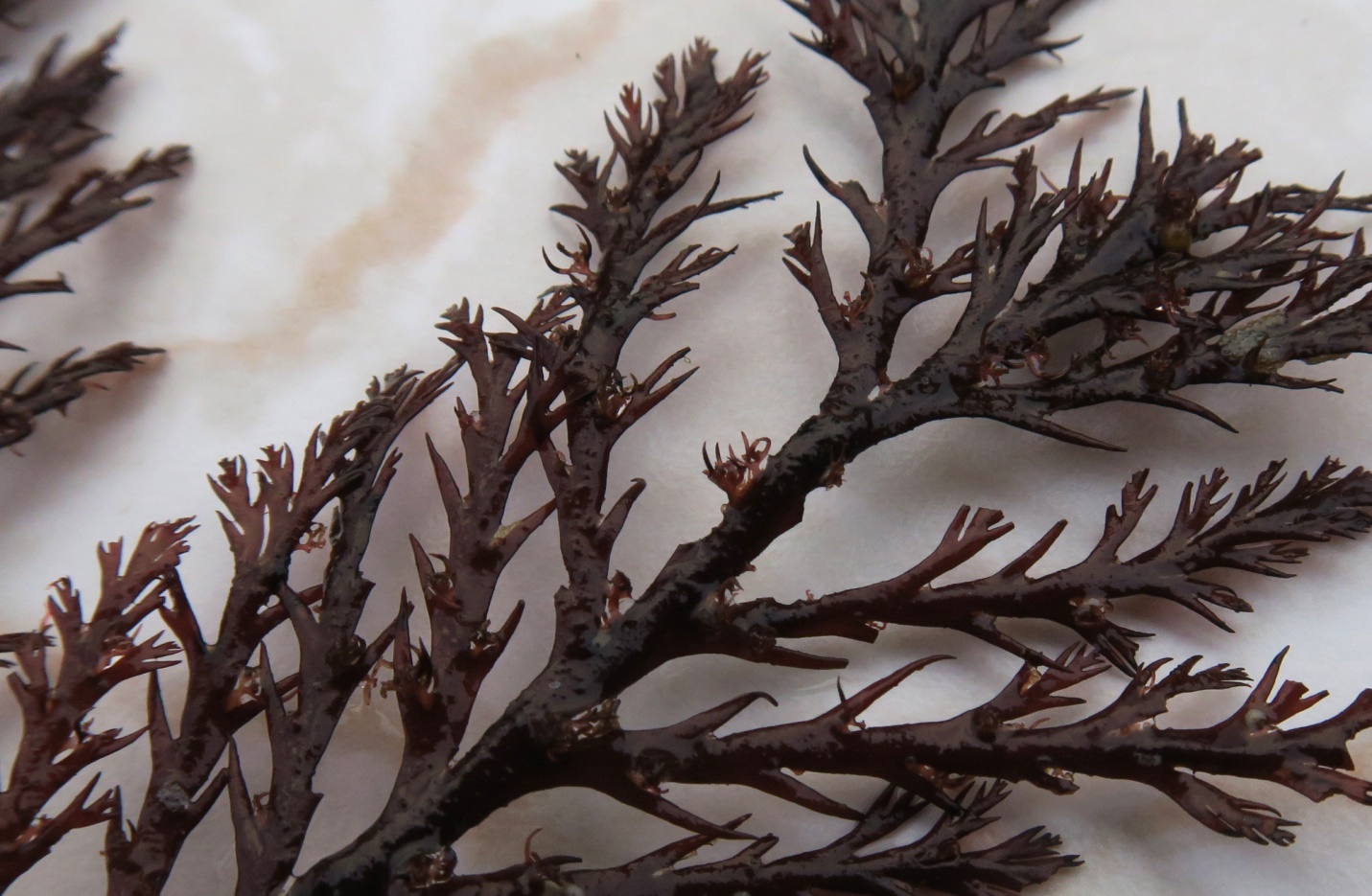
Figure 3: Out of water and zoomed in to much larger than life-size, this image shows the reproductive structures that are developing on this early January washed ashore specimen. Gonzales Bay, Juan de Fuca Strait, B.C., Canada. January 6, 2023. Photo ID 27502 ©Seaweedwhisperings.com
Day 2, Further Interactions:
Person 1:
Woke up at 00:30 from a dream where I needed to take my pet T. Rex out for a walk. I was pondering whether or not it needed to be on a leash.
Discussing this dream with Person 2 I realized there might be a connection with the Whispering, particularly related to the O.W. reproductive structures. Looking at some of the photos of the reproductive structures yesterday I would say that some sure look like the classic caricature of T. Rex, with mouth wide open displaying fearsome teeth.
For my written discussion in this Whispering I don’t want to spend the time writing out the name of the seaweed or the dinosaur, thus using O.W. and T. Rex. Impatient to move on and complete.
Not hurried, but pragmatic and to the point.
Serious, committed.
Teeth “mean business”. The right tool for the task, and they are going to use it.
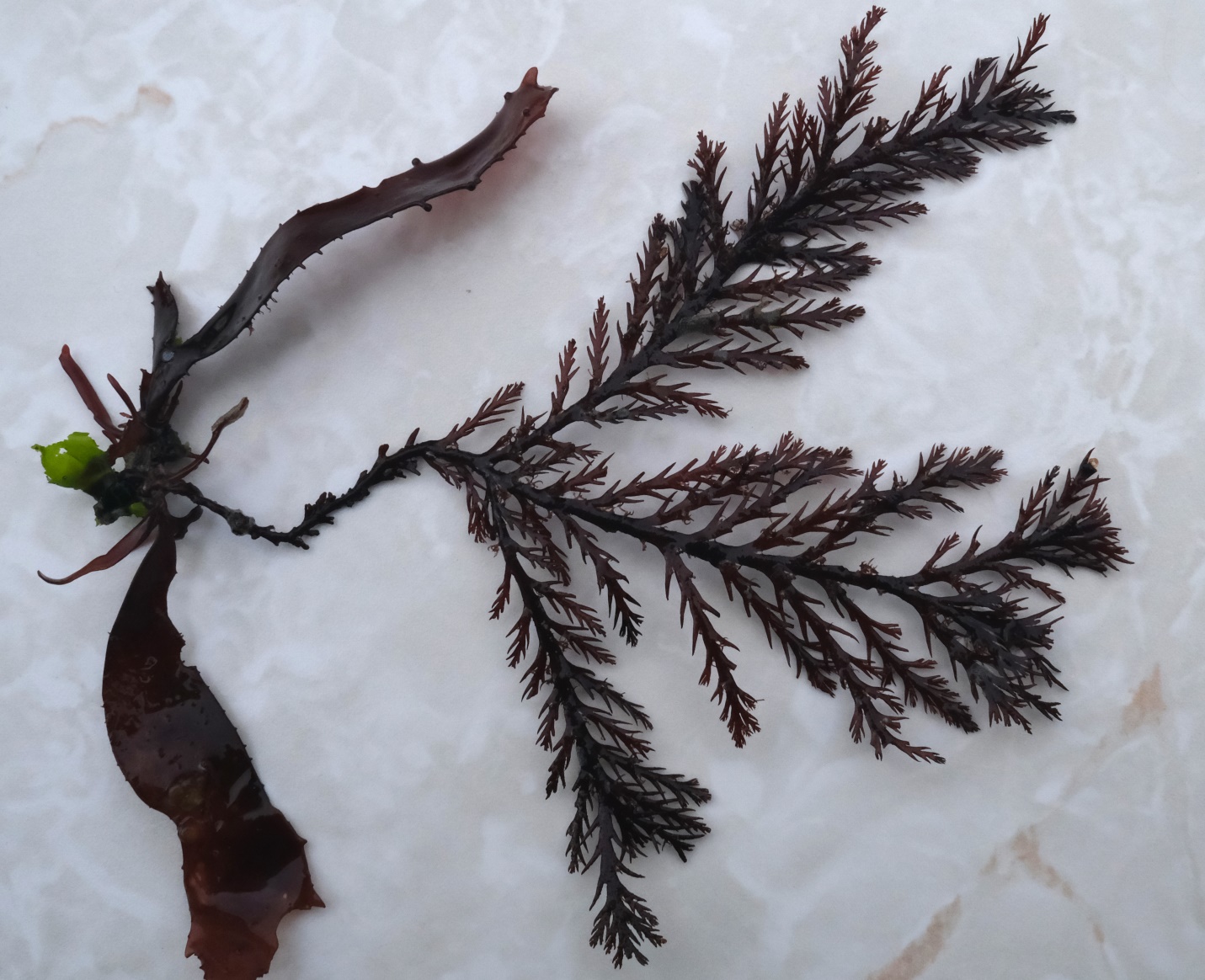
Figure 4: The resemblance to a conifer twig such as juniper or cedar is strong in this seaweed – were its color green, it would be remarkably alike. This photo shows the entire specimen that Person 1 collected washed ashore at Gonzales Bay. It is growing in association with a Prionitis sp. and a small patch of Ulva, too. Gonzales Bay, Juan de Fuca Strait, B.C., Canada. January 3, 2023. Photo ID 27503 ©Seaweedwhisperings.com
Person 2:
I slept long and deeply last night. I realized that what had occurred with this Whispering was a bit different and notable. For Day 1, both Person 1 and myself woke very early and it was with the feeling we were to “get on with” our interactions with Toothed-Twig Seaweed. We both agreed this was what had motivated our very early start to the day. We are not unaccustomed to early starts and we often have chosen hours such as this to meet low tides in situ. Typically when we do this we maintain our energy well throughout such days, but yesterday, after having interacted with Odonthalia washingtoniensis, I was left out of balance. I could not put much effort at all into other work; I was spinning my wheels, doing nothing much really, had no energy to generate any new work output. It was like I could not engage; it was unavailable to me. All of this was notably strong, and especially in contrast to my earliest perceptions of the determined nature of this seaweed that felt to me could be best expressed as, “Let’s tackle this!” and, “Let’s get this job done!”
Later this second day I continued with my interactions:
You do look so very much like a cedar twig or branch, Odonthalia washingtoniensis.
Distinctive in form.
Firm.
And enduring. Yes, you show an ability to suffer damage or other hardship and to endure, even regenerate, I think.
You may not always be in your beautiful red and neatly ordered form, but if you get “half a chance”, you’ll return to it as best you can.
I think you can sometimes pour a massive amount of energy into such regeneration, and I’ve seen that in another specimen (one found almost exactly one year ago).
Given that you grow only in sub-tidal regions, I only ever observe you, Toothed-Twig, when you have washed ashore. At those occasions you have obviously incurred at least some level of disturbance and damage, and so I have found myself wondering..., in your sub-tidal habitat just how much breakage of branches and other parts happens?
Do red rock crabs crawl over you and cause some impact? Does the giant Pacific octopus or the gum boot chiton wander by and break parts of you? Do crab traps and fish hooks from human fishing efforts snag you and break you?
It doesn’t seem that you are weak physically; your thalli seem to be both firm and also quite pliable. So maybe much of the damage I have seen is on individuals that have been broken away from their base (holdfast). Then you continue to live, to endure, but without your anchor point you do collide with things and this does damage you.
So again, strong endurance, but thrives and glows deeply and beautifully red only when connected to its base.
I think somehow, too, Odonthalia washingtoniensis, that you don’t really consider the importance of your base when it is in place. At those times your determination and direction have you fully engaged in striving onwards. But if your anchor point is lost, if you are torn from it, then you suddenly face many difficulties and challenges that rip you away from your previous focus. The value of your base is then obvious, but it also cannot be recovered.
What then? Is this when you face a reckoning with your own ways?
When you are damaged, you lose color, blacken and then break off.
Is it then in your new growth that experience and learning is expressed? Or is this a “lesson” that keeps repeating?
Or is it a “trimming” mechanism, a “fail-safe” measure that keeps you from becoming over large, out of balance with yourself?
Toothed-Twig, your reproductive efforts are dramatic and profuse. The parts themselves are strange looking in that they seem as if they almost don’t quite fit or ‘belong’ with the rest of you. And each little reproductive “bud” is shaped in such a way to seem that the inwardly curled spiny extensions are shielding and protecting a central treasure (in specimens from February 2021 this central part is visible as a spherical growth).
The whole color of the reproductive “buds” seems brighter and lighter, more translucent; they shine a bit like treasure – gold and gems and shiny coins.
Ah, the future is promising, indeed!
But is it hard for you, Odonthalia washingtoniensis, to get established in a good and suitable home? Is this why such a profusion of reproductive cells is generated?
Or is it like I earlier sensed with you, that when you get started with a job or endeavor, you really go for it with your full energy and determination.
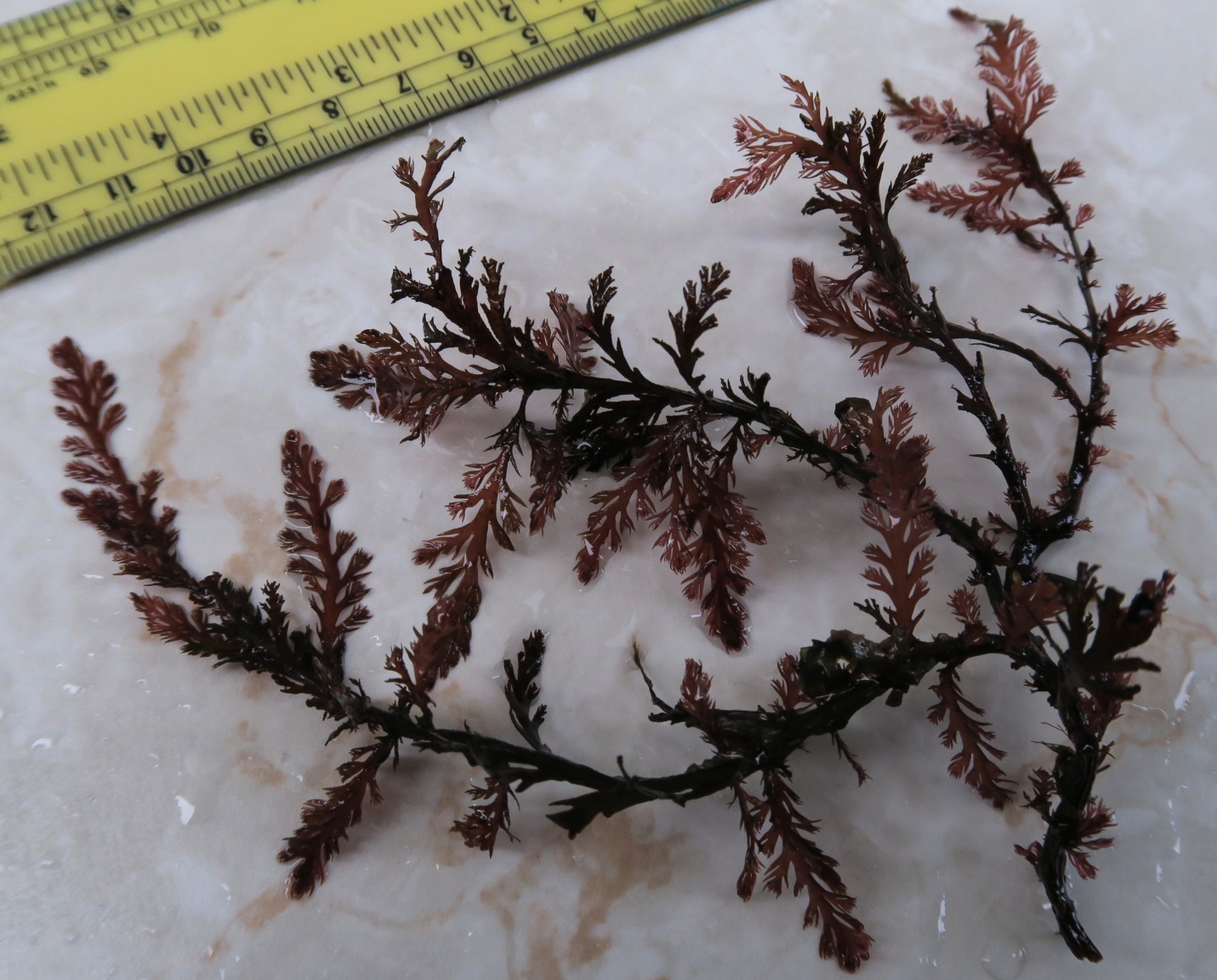
Figure 5: This rather ‘different’ looking Toothed-Twig Seaweed was found almost exactly 2 years prior to our Whispering specimen. Here there has been significant damage to the very dark red older parts of the thallus and at multiple locations new, lighter pinkish red colored growth is ‘regenerating’. Had this specimen been damaged while still affixed to the substrate or has all this new growth happened while it’s been floating adrift on the winter seas? Gonzales Bay, Juan de Fuca Strait, B.C., Canada. January 4, 2021. Photo ID 27504 ©Seaweedwhisperings.com
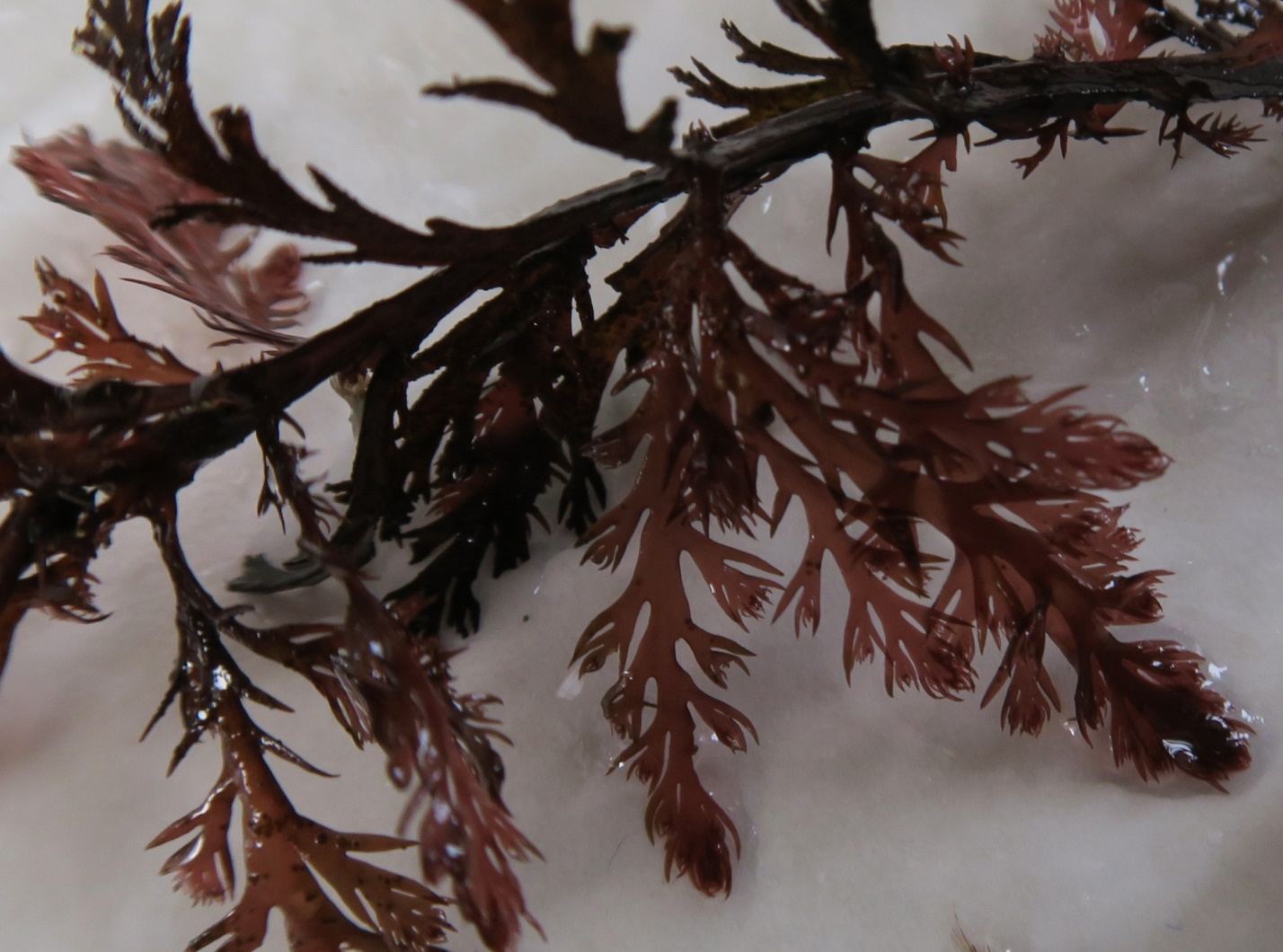
Figure 6: This much closer view shows the new growth on the same specimen seen in Figure 5. The ‘flattened’ nature of this seaweed’s morphology is obvious here. Gonzales Bay, Juan de Fuca Strait, B.C., Canada. January 4, 2021. Photo ID 27505 ©Seaweedwhisperings.com
Day 3, Dream:
Person 2:
A snippet of a dream occurred last night and after I woke from the dream snippet I recalled that I had dreamed a very similar dream just the night before. What was happening in the dream was that a person was going to have their hand chopped off. I’m fairly certain this was not a planned surgical amputation but that there was something more coarse and primitive behind the action. In the dream the thought came to me, “Oh no, but this person uses that hand so regularly and with such skill in their work – what a tragedy, what a loss!”, and then in the next moment I thought / ‘knew’, “Oh, but yes, they WILL adopt another way to achieve the same prowess, even without their one hand.”
I wondered if this dream was linked to my ponderings about the ‘regenerative’ (this was the only word that “fit” for what I was getting) growth I could see in one specimen of Odonthalia washingtoniensis? And in the dream it was one “hand” that was going to be cut off – and simultaneous to knowing the value of that hand to the person there was such a strong knowing that this loss would be ok; that good function would continue for the person in spite of this.
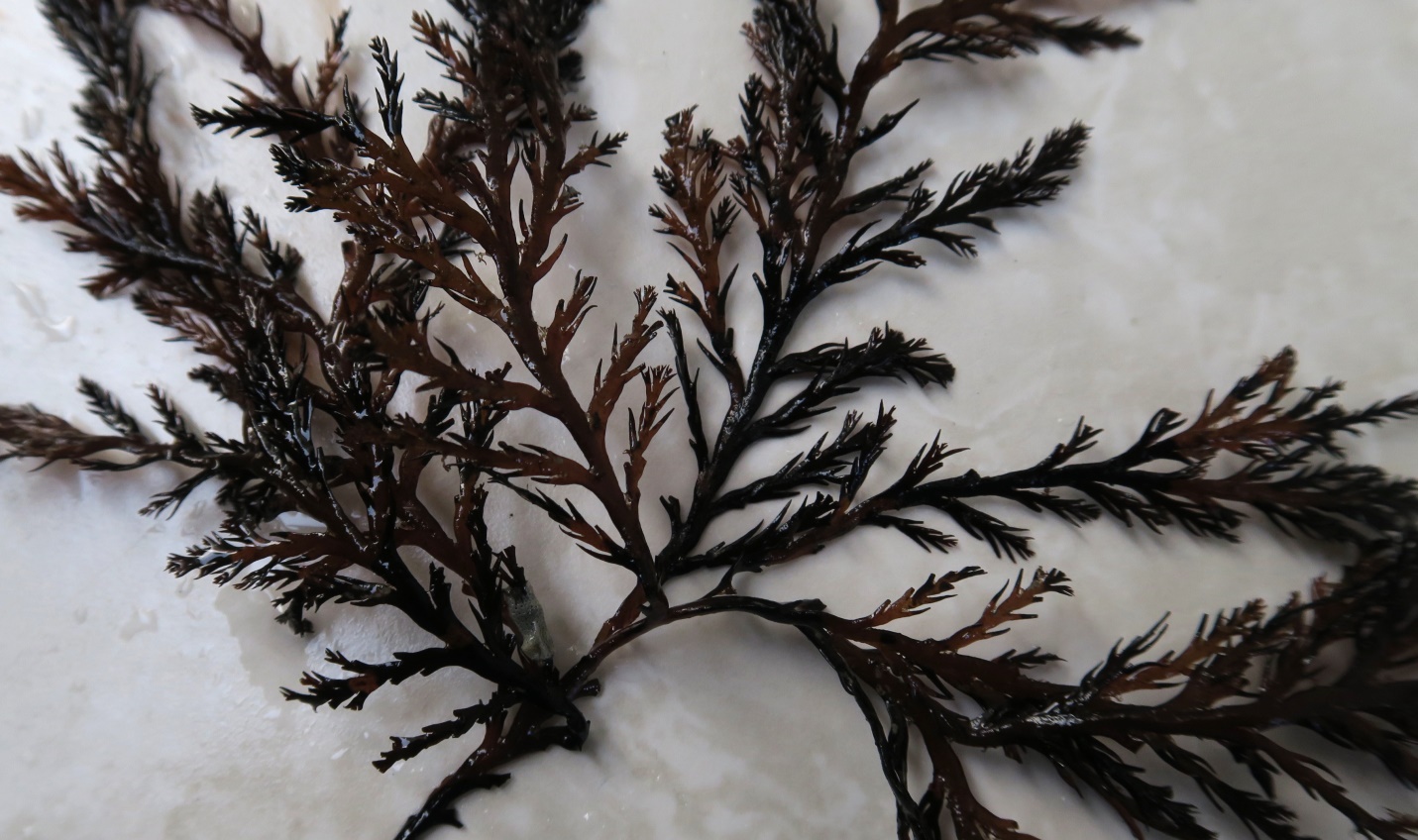
Figure 7: A different specimen from 2 years earlier shows the black or very darkened parts in combination with areas that are a “healthier” red. Gonzales Bay, Juan de Fuca Strait, B.C., Canada. January 4, 2021. Photo ID 27506 ©Seaweedwhisperings.com
Discussion:
Impatient to move on and complete. Person 2 was initially hesitant to say this seaweed has an energy of impatience but that trait really does some to be present. It’s about moving onward, in their directed focus, don’t want to stop or be interrupted. So, waiting for us to commence our ‘listening’ was like an interruption to O.W.
Teeth, like T. Rex, that are fearsome..., such teeth can tear and rip. Care is needed when handling Odonthalia washingtoniensis. Why? They can bite, especially if you’re holding them back or restraining them. This is when anger can erupt. On the flip side, does O.W. suffer injuries of being torn or ripped - this kind of violent and sudden damage? It seems that is quite probable, too. And this may be why it has a strong regenerative capacity.
Damaged parts turn black, and break off. This is unlike many other red algae that bleach but also retain their faded parts. This concept, the look of it, is reminiscent of gangrene. Possibly this is what the hand chopped off dream was all about.
There are many small ‘imperfections’ in O.W. – bryozoans and other marine life living on it, small parts broken away or some areas of distorted color, but these are not anywhere nearly so limiting as the black of gangrene, and they are not nearly as visible. One has to look closely to spot them, and for O.W. themselves, these small physical imperfections are not limiting whatsoever. And for the observer, seen from a distance O.W. looks rather much free of imperfections; they are overlooked easily by the striking good looks overall.
There is sadness about irreparable damage in Toothed-Twig Seaweed. Not anger, but sadness in what has been lost. When things are suddenly “broken” like this there is a deep sadness and this feeling may endure long after the “part” is lost – sadness and a longing for what has been lost. Perhaps one of the dreams gives a hint at what would be helpful for Odonthalia here – that is to completely “let go” of the “cut off” and “lost” parts and to forge ahead with full knowledge that other ways will be developed that yield equal or even better abilities or results.
But such strong emotion is not routine for O.W. They can be stoic and are usually very matter of fact in their presentation. There is not much in the way of embellishment. What is shared can seem more like a type of reporting than an exploration and emotional representation.
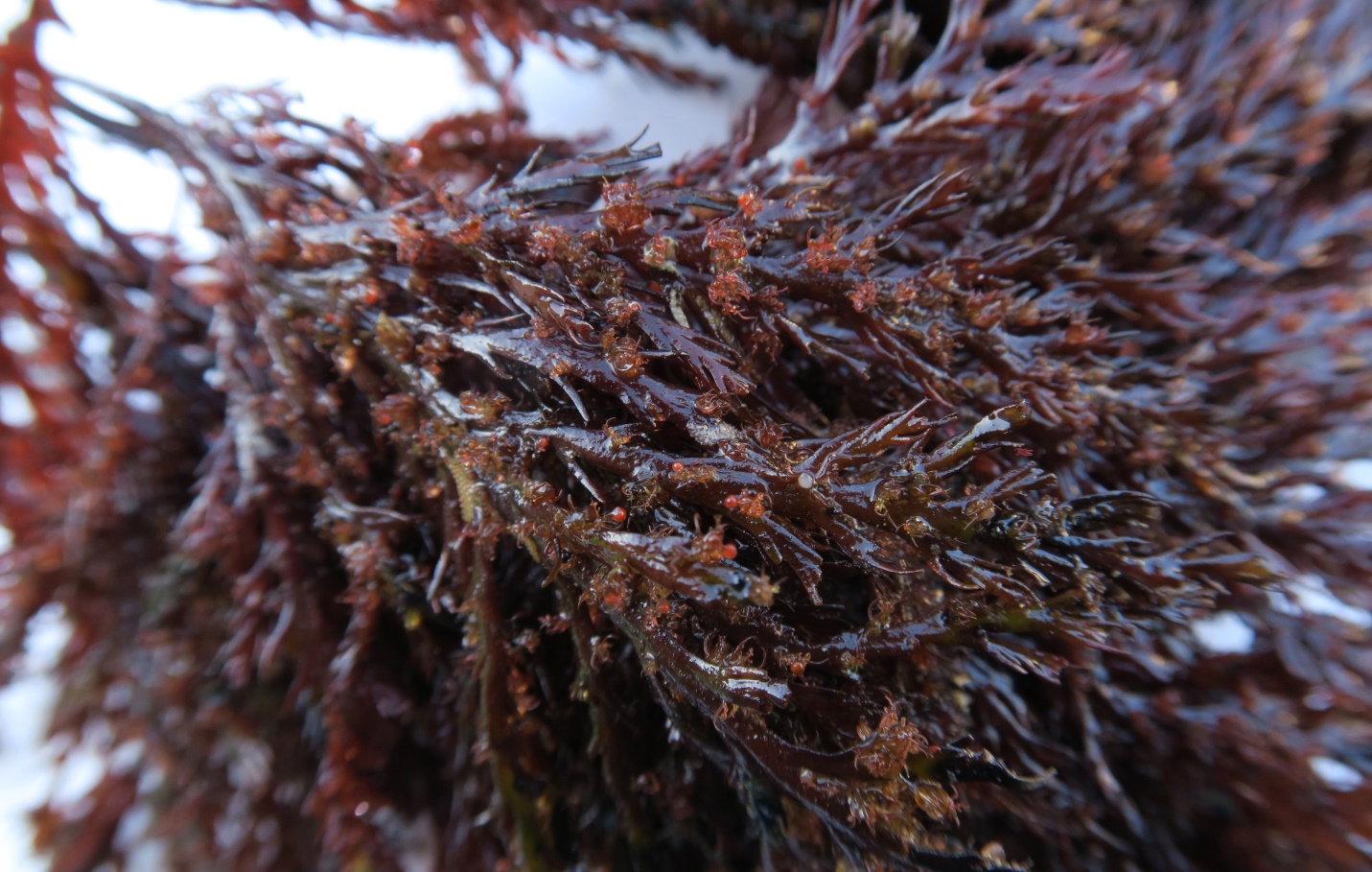
Figure 8: A very ‘bushy’ specimen of Odonthalia washingtoniensis is viewed here and this was a little further along in the season (about one month) – as a result the reproductive structures are profuse and prominent. Gonzales Bay, Juan de Fuca Strait, B.C., Canada. February 9, 2021. Photo ID 27507 ©Seaweedwhisperings.com
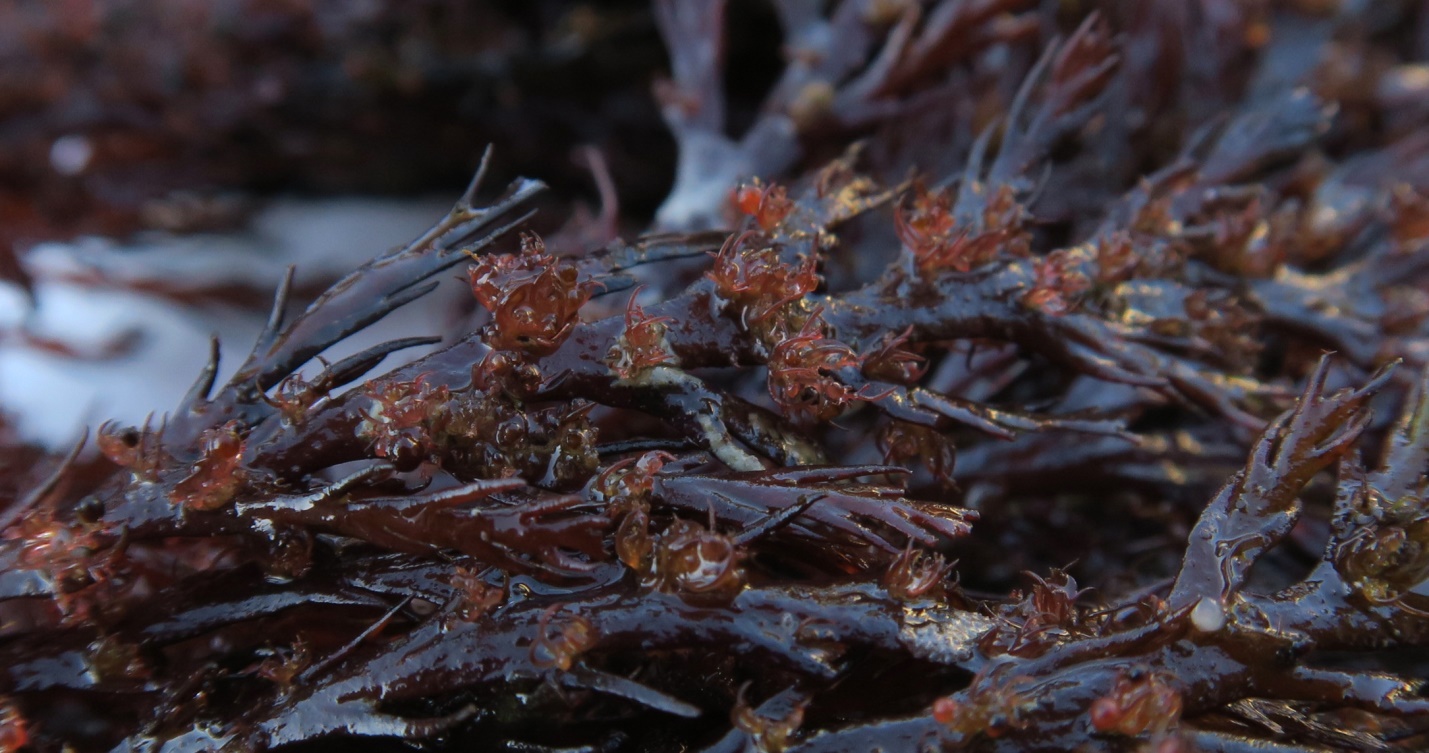
Figure 9: This enlarged view gives a look at how the reproductive structures appear in early February. This species of Odonthalia was first described from specimens collected at Friday Harbour, Washington, hence the species name – washingtoniensis. Gonzales Bay, Juan de Fuca Strait, B.C., Canada. February 9, 2021. Photo ID 27508 ©Seaweedwhisperings.com
Biology & Natural History Information:
Description:
The characteristically flattened branches of this red alga feel quite tough when touched and can grow to 30 cm long. This species is freely branching and this creates a bushy appearance. One common name, Flat Sea Brush, describes a distinctive feature of this species in that the main stems and branches are strongly flattened (in comparison to other members of the genus). The color varies from brownish read to blackish brown.
Habitat:
Grows in the shallow subtidal and occasionally low intertidal zones. Although this species occurs from Alaska to northern California, it is almost strictly subtidal south of Washington State.
Distribution:
Eastern Aleutian Islands, Alaska to San Luis Obispo County, California.
Remarks:
This seaweed was originally described in 1925 from collections made at Cattle Point, San Juan Island, in the vicinity of the Biological station at Friday Harbor, Washington State.
Classification:
Phylum: Rhodophyta
Class: Florideophyceae
Order: Ceramiales
Family: Rhodomelaceae
Genus: Odonthalia
Species: Odonthalia washingtoniensis Kylin 1925
Former name(s): Unlike many other types of seaweed, this species has retained its original name since its discovery in 1925.
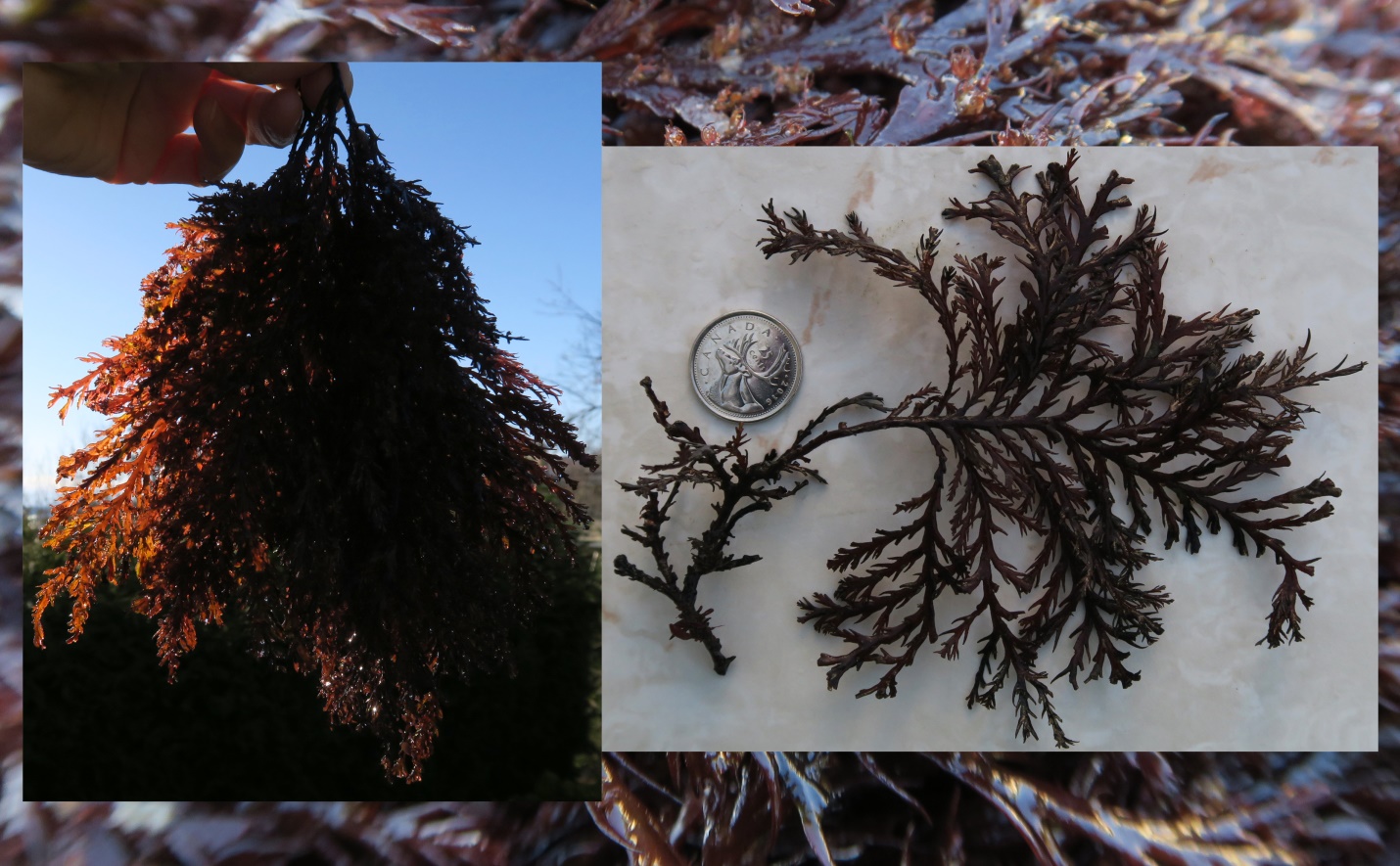
Figure 10 (Left): Displayed aloft is the largest complete ‘bush’ of Odonthalia washingtoniensis we’ve ever encountered. (Right): Is the much more commonly encountered “twig” of this species. The December washed ashore specimen shows no reproductive structure growth at all, and the February one is replete with them. Gonzales Bay, Juan de Fuca Strait, B.C., Canada. December 13, 2020 (right) and February 9, 2021 (left). Photo ID 27509 ©Seaweedwhisperings.com
![]()